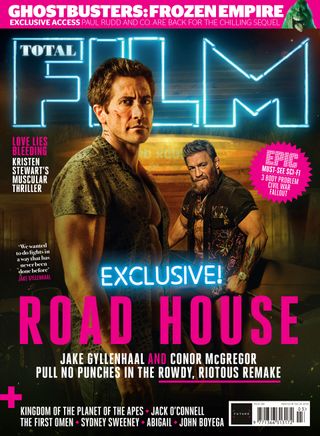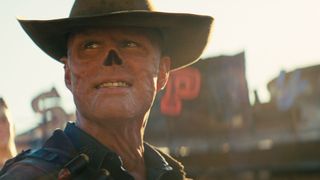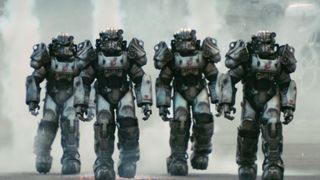Fallout TV show writer explains how Todd Howard and Batman helped shape an original story
Exclusive: In the video-game adaptation Fallout, the end of the world is only the start of the fun

There is a moment near the beginning of Fallout 3 – the landmark 2008 action role-playing game from Bethesda Games Studios – that is imprinted on anyone who experienced it at the time. In it, the player-created main character opens the exit to the subterranean vault they’ve called home for 19 years, and steps into the blinding light of the Wasteland for the first time, a literal world of potential stretching as far as the eye can see.
‘I was, right out of the gate, blown away,’ says Jonathan Nolan, the co-creator of HBO’s Westworld and co-writer of The Dark Knight, The Dark Knight Rises, The Prestige and Interstellar, alongside big brother Chris. During a conversation with Total Film in early February, Nolan is reminiscing about ‘looking for a new distraction’ in late 2008, months after The Dark Knight hit cinemas, and being drawn to a copy of hot new thing Fallout 3.

This article first appeared in Total Film issue 348. Subscribe here to never miss an issue!
‘I was obsessed with the game, and obsessed with the world of it,’ a visibly animated Nolan says over Zoom. ‘The ambition of it, and the mythology of it, and the sophistication of the world, and the gravitas of it. What really got to me, though [was] the weirdness of it, and the gonzo, satirical, impossible-to-place tone of this thing. You very seldom see anything like this.’
Contradiction is at the heart of Fallout. Take that first in-game glimpse of the open world. The paradox of this moment is that, for all the freedom it promises, everything in front of you is extremely dead. The toxic landscape is dotted with the decrepit relics of a once-thriving civilisation, some two centuries after a nuclear judgement day has driven the haves underground and left the have-nots to fend for themselves on the surface with irradiated cockroaches the size of house cats and even more monstrous mutants.
Life is as grim as it gets in the Wasteland, yet the tone of the Fallout TV show is anything but. Nolan describes the series as ‘closer to comedy’ than anything he and Lisa Joy have made to date. Leaning into Fallout’s contradictions, Nolan and Joy, who were still working on Westworld while initially developing Fallout in 2019, made the unusual decision to hire a pair of showrunners with wildly divergent backgrounds: Geneva Robertson-Dworet (Captain Marvel, Tomb Raider) and Graham Wagner (Silicon Valley, The Office).
‘Geneva comes from the comic-book world like me, whereas Graham comes from comedy,’ Nolan points out. ‘That was kind of the approach – a little bit of David Lean, and a little bit of straight comedy,’ he nods. Much of Fallout’s humour comes from its deeply embedded critique of consumer corporatism. The Wasteland is littered with the retro-futuristic detritus of mega-corporations like Vault-Tec, and its grinning mascot Vault Boy, who is often glimpsed giving a big, incongruous thumbs-up.
‘There’s all this branded stuff,’ Robertson-Dworet says. ‘And it seems to imply that whatever brought the world to the end was the hyper-corporatisation of that pre-war society.’ ‘It’s given us a fair bit of joy to be able to do that on Amazon Prime Video,’ adds Wagner, with a chuckle. ‘That is the paradox of America.’
Sign up for the Total Film Newsletter
Bringing all the latest movie news, features, and reviews to your inbox
Game changer

Fallout has arrived at a fascinating moment for video-game adaptations. Once the subject of a decades-long ‘curse’, preconceptions that game-based movies and TV shows are likely to fail were well and truly upended by HBO’s acclaimed adaptation of The Last of Us a year ago. ‘Now there’s an expectation of: “No, they can actually be great. I watched some good ones,”’ says Wagner with a smile. ‘In a perverse way, I wish there was more snobbery so that we could have been the first!’
Both may be violent stories set in a post-apocalyptic America, featuring zombie-adjacent creatures, but the comparisons between TLOU and Fallout end there. Most significantly, while the former faithfully (some might say slavishly) replicates the game’s narrative on screen, Fallout is telling an original story in a new location for the series – Los Angeles – but all set in the same canonical American Wasteland as the games.
‘From the first conversation with Todd [Howard, game director of Fallout 3 & 4, and an executive producer on the show] we were most excited about an original story,’ says Nolan. ‘Fallout, in my career, is closest to the work we did in adapting Batman, where there’s so much storytelling in the Batman universe that there is no canonical version of it, so you’re free to invent your own. Each of the [Fallout] games is a discrete story – different city, distinct protagonist – within the same mythology. Our series sits in relation to the games as the games sit in relation to each other. It’s almost like we’re Fallout 5. I don’t want to sound presumptuous, but it’s just a non-interactive version of it, right?’
With a typical playthrough of Fallout 3 or its 2015 sequel, Fallout 4, taking upwards of 100 hours, and players afforded the freedom to engage with as little or as much of the world and its wacky inhabitants as they want, the challenge was ‘how do we evoke all the great parts of Fallout efficiently, and in a way that is meaningful to us?’ according to Wagner. ‘By telling an original story, we felt like we could welcome people who weren’t familiar with the games to the key tenets of a Fallout storyline,’ adds Robertson-Dworet. ‘Which are: a Vault-dweller going to the surface for the first time, and having their morality challenged; exploring the Power Armour through the Brotherhood of Steel; and The Ghouls, who are the most benighted of all the people on the surface. So we wanted to look out for them, and, in fact, put our favourite actor of all time, Walton Goggins, into that role.’
Ghoul & the Gang

Goggins doesn’t have just a role; in fact, he has two. We first meet him as Cooper Howard – a down-on-his-luck former western star, who is the entertainment at a kids’ party on the day the nukes detonate and change the world of Fallout forever. Howard features throughout the show in flashbacks that will expand on how, 219 years later, he has become The Ghoul – a necrotic, gunslinging mercenary whose life has been indefinitely prolonged by exposure to radiation and a cocktail of chemicals that keep him from turning feral.
A standout supporting player in The Shield, Justified and two Tarantino westerns, but with criminally few leading roles to his name, Goggins admits to having no idea what Fallout was initially. ‘All I needed to know was that Jonathan and Lisa were behind it,’ he nods. ‘Then they started describing the character. And I was like, “Really? So I don’t have any hair? I’ve been walking in a Wasteland for 200 years? OK!”’
In order to portray The Ghoul, Goggins spent an hour and 45 minutes having a deceptively thin prosthetic headpiece applied every morning, undergoing a radical transformation into a character he describes as ‘the good, the bad and the ugly’ rolled into one. ‘What we kept coming back to was that we wanted the audience to not be repulsed by the visual of The Ghoul; but, rather, to lean into it, and to look at his face, and to become obsessed with it,’ Goggins says. ‘And to make him sexy, on some level. To make him irresistible.’
Certainly, The Ghoul has a swagger and a confidence in his capabilities that make him cool, calm and collected, even when drastically outnumbered in a gunfight. Goggins turned to numerous iconic western stars for inspiration: Clint Eastwood, Lee Van Cleef, James Coburn, Alan Ladd, James Arness, Paul Newman, but in particular, ‘I really, really watched, over and over again, Henry Fonda in Once upon a Time in the West, and the way in which his energy comes into the room before he does. The way he moves with very little effort, and he never really speaks above a whisper.
The Ghoul is hired to track down Wilzig (Michael Emerson), a scientist with a valuable secret in his head, causing him to cross paths with Ella Purnell’s former Vault-dweller Lucy and Aaron Moten’s Brotherhood of Steel squire Maximus, who make up the cast’s interconnected core trio.
When we meet Lucy, a life-long resident of Vault 33, her father, Hank (Kyle MacLachlan) has arranged for her to be married to a suitor from Vault 32. Her destiny as a wife and mother is about to unfold exactly as she’s always been told it will.
‘Lucy is highly trained and smart, and is this A1 put-together type,’ Purnell says. ‘She truly is a good person, and believes in the Golden Rule, and that her children’s children will go to the surface one day, and rebuild America. She believes in doing her duty, and procreating, and creating the future. And then through a series of unfortunate events, she ends up going to the surface and leaving the Vault, and finding that may not be entirely true.’
On the surface, Lucy quickly learns that morality is a privilege. ‘Lucy is able to be this noble person back in her Vault, because she’s never wanted for anything,’ Robertson-Dworet says, ‘And as soon as she’s on the surface, every decision becomes a lot harder.’ That’s certainly true for Maximus, a member of the quasi-religious Brotherhood of Steel – a technocratic paramilitary order whose primary aim is to locate, preserve and regulate pre-war technology. This is achieved through the use of Power Armour (see boxout, right), metal suits that turn Brotherhood Knights into walking tanks. ‘They usually use violent means in order to achieve their goals,’ says soft-spoken Moten. ‘Maximus enters as a young initiate, and is hoping to rise in the ranks of the Brotherhood.’
Max is a squire, tasked with carrying his Knight’s oversized bag into battle and, er, polishing his codpiece. But it’s all in aid of something greater than himself, Max dedicating his life to the order after being saved by the Brotherhood as a child. ‘He wants to be a hero,’ Wagner says. ‘He wants to be chivalrous. But he finds out that the Brotherhood is not quite what it seems. And so the question is: how can he actually live up to his ideals if the institution that he’s part of is so problematic?’
Armor Wars

Incredibly, the Brotherhood’s Power Armour was a practical costume, worn by stunt performer Adam Shippey. ‘I’ve learned this with my brother, and with all the projects that we’ve worked on over the years – it’s always better if you can make it real,’ notes Nolan, who currently has a suit of Power Armour sitting in his garage. ‘We stole a trick from the original Alien. The Xenomorph [costume] was built around one terrifically talented performer, who had a very unique build, which allowed them to sculpt the suit in such a way that it doesn’t feel like there’s a person there. Even then, I still imagined that we would have to use a bit of trickery and replace the suit with CG in a lot of places, but 99% of what you’re seeing is Adam walking around in that suit.’
For the cast, the suit was a special effect whose impact never waned. ‘It’s one of those things where you needed someone to tell you to close your mouth,’ says Moten. ‘You’re just gaping at this thing. And the way that you see people behave – whether it’s background actors or our crew – everyone needs to move out of the way.’
‘I remember there was one point where he took a couple of fast steps towards me,’ adds Purnell. ‘I backed up off my mark and was completely out of focus, because that’s your gut reaction to this robot transformer-looking dude who’s humungous.’
Nolan himself directed the first three episodes, shooting primarily on location on the Skeleton Coast of Namibia and the Western Salt Lakes of Utah to capture a sense of the games’ ‘beauty and scope’, while staying uncompromisingly true to the series’ outrageously OTT violence (‘It’s definitely a hallmark of the game that we knew we had to translate into the series’). He also thought deeply about how to replicate the experience of playing the game in a passive medium. ‘The way in which you interact with these games, there’s as much cultural anthropology as there is violence,’ he explains. ‘You’re sifting through the leavings of a world that has been destroyed. To take that freedom and eliminate it as a filmmaker is intimidating. You’re taking away interactivity, and you’re replacing it with intentionality, which is exciting. I think that’s why there’s a place for adapting video games.’
Certainly, everyone involved is excited enough by what they’ve made that no one is ruling out a return to the Wasteland. ‘It’s an uncertain time in television. So the art form of season finales has become: provide enough closure, but leave the door open for more,’ Wagner admits. ‘But we feel we’ve barely scratched the surface of the Fallout universe. We literally have documents and documents of stuff that we’re, in success, eager to dig into. Our fingers are crossed that we’re going to get the opportunity to do all that stuff.’
Fallout is released on Prime Video on April 11. For more, check out all the other upcoming video game adaptations on the way in 2024 and beyond.
Subscribe to Total Film magazine here to never miss a feature like this.

I'm the Deputy Editor at Total Film magazine, overseeing the features section of every issue where you can read exclusive, in-depth interviews and see first-look images from the biggest films. I was previously the News Editor at sci-fi, fantasy and horror movie bible SFX. You'll find my name on news, reviews, and features covering every type of movie, from the latest French arthouse release to the biggest Hollywood blockbuster. My work has also featured in Official PlayStation Magazine and Edge.
Most Popular






